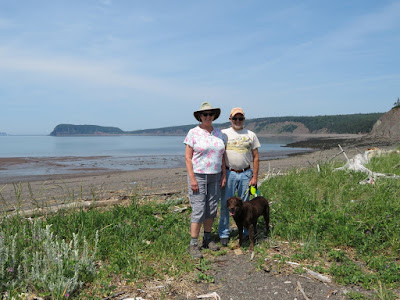 |
| Oh those huge Fundy tides! |
It is hard to describe tides so
tall that beaches stretch forever toward the sea at low tide and become thin slivers
of gravel when the tide is high. We saw a
10 foot tall fishing weir (nets attached upright on poles driven into the ocean
floor), an ancient First Nation fishing technology still used today, stranded
on the beach well above the tide line and yet it was to be completely submerged
(and catching fish) at high tide. People
walking along the waters edge at low tide, seem to be as small as children in
the distance because they look so tiny to you as you stand where the high tide
had been. Wide river beds are almost dry
with thin trickles of water and then completely fill as the tide comes in.
 |
| Stranded fishing weir waiting for the tide to come in |
You probably already knew that the
Bay of Fundy is famous for extremely high tides, the highest in the world. Its’ unique funnel shape and the orientation of the funnel channels the water
driven by the moon into an increasingly narrow basin, causing that basin to
fill more and more with higher and higher tides. We have 2 foot tides at home. The tides on Fundy are 20 feet near the
widest opening of the Bay, 40 feet further up the Bay, and 50 feet in Parrsboro,
Nova Scotia where peninsulas from both sides further constrict the water flow.
 |
Imagine the force of all that
water moving up and down the Bay four times a day on a 25 hour cycle. Scientists have set up a test facility called
Fundy Ocean Research Centre for Energy (FORCE) in Parrsboro, where the tides
are the highest, to test the feasibility of harnessing the power of the tides
to generate electricity. Four groups are
designing and building different types of machines that could generate
electricity while withstanding the force of the tides and without harming the
plants and animals that live in the water.
 |
| The test location is between this shore and the giant rock island off shore |
Only one of these massive
machines has been tested so far. It was
not able to withstand the strength of the massive water push, so is being
redesigned. As a result, some of the
other projects are being redesigned as well with this new information. There is tremendous commercial potential for
a successful machine that can make electricity out of tidal energy. It was fun to be at the place where the big
thinking and testing is happening.
A movie of a tidal bore
The Fundy tides are so forceful,
that they cause rivers to flow backwards when the tidal water starts pushing up
the river channel. The place where the
river and tidal waters meet is a wave that is called a tidal bore. There are big bores in bigger rivers, and
tourists can white water raft along the top of the bore wave. We saw a small bore in a smaller river in
Maccan, Nova Scotia. There we met Gordon
Boss, who is in his 90’s and has been watching and charting that particular bore most of
his life. He publishes a bore time chart
predicting when the bore will occur at that bend in the river where it can be
viewed at a public park. He watches out
his front window, and when cars (or, in this case, a motor home) pull into the
park, he drives down from his home to enjoy the bore with you, to answer
questions about the bore, and to tell you stories about special bores he has
seen. It was so sweet and wonderful to
meet him.
 |
| Tide coming in |
 |
| Tide going out |
We were fortunate to camp in two
different campgrounds right on the Nova Scotia Fundy shoreline. The principle occupation of the other campers
was to sit and watch the waters approach and recede. One evening, a bald eagle landed on the newly
uncovered beach to dine on a tasty tidbit stranded there by the receding tide. He repeated this ritual the next day for
breakfast. He was far enough away to not
be worried about all of us watching him eat.
He was close enough that we could see him. We decided that watching the tides was a
pretty special occupation.
 |
| Do you see the tiny people at the high tide line? |
This is the first of several
posts about the Bay of Fundy, and in the ones yet to come, the tides will be a
significant part of the narrative.
No comments:
Post a Comment